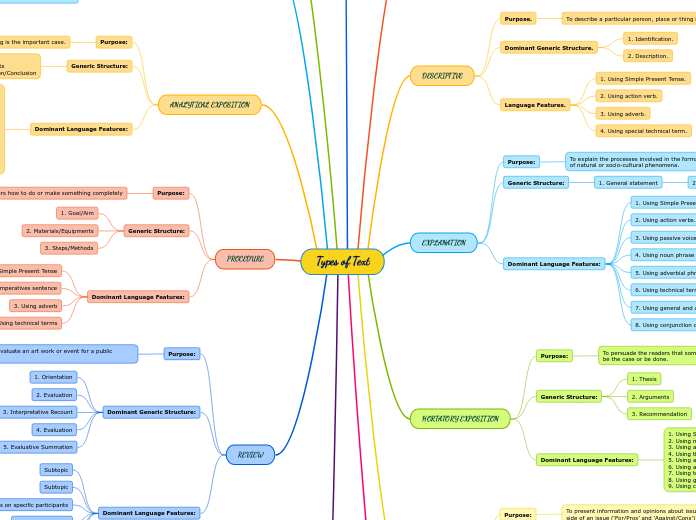Types of Text
NEWS ITEM
Purpose
To inform readers about events of the day which are considered newsworthy or important
Dominant Generic Structure:
1. Newsworthy event
2. Background events
3. Sources
Dominant Language Features:
1. Short, telegraphic information about story captured in headline
2. Using action verbs
3. Using saying verbs
4. Using adverbs : time, place and manner
NARRATIVE
Purpose
To amuse/entertain the readers and to tell a story.
Generic Structure:
1.Orientation.
2. Complication.
3. Resolution.
4. Reorientation (optional).
Dominant Language Features.
1. Using Past Tense.
2. Using action verb.
3. Chronologically arranged.
DESCRIPTIVE
Purpose.
To describe a particular person, place or thing in detail.
Dominant Generic Structure.
1. Identification.
2. Description.
Language Features.
1. Using Simple Present Tense.
2. Using action verb.
3. Using adverb.
4. Using special technical term.
EXPLANATION
Purpose:
To explain the processes involved in the formation or working of natural or socio-cultural phenomena.
Generic Structure:
1. General statement
2. Explanation
3. Closing
Dominant Language Features:
1. Using Simple Present Tense.
2. Using action verbs.
3. Using passive voice.
4. Using noun phrase
5. Using adverbial phrase.
6. Using technical terms.
7. Using general and abstract noun.
8. Using conjunction of time and cause-effect.
HORTATORY EXPOSITION
Purpose:
To persuade the readers that something should or should not be the case or be done.
Generic Structure:
1. Thesis
2. Arguments
3. Recommendation
Dominant Language Features:
1. Using Simple Present Tense
2. Using modals
3. Using action verbs
4. Using thinking verbs
5. Using adverbs
6. Using adjective
7. Using technical terms
8. Using general and abstract noun
9. Using connectives/transition
DISCUSSION
Purpose:
To present information and opinions about issues in more one side of an issue (‘For/Pros’ and ‘Against/Cons’).
Generic Structure:
1. Issue
2. Arguments for and against
3. Conclusion
Dominant Language Features:
1. Using Simple Present Tense
2. Use of relating verb/to be
3. Using thinking verb
4. Using general and abstract noun
5. Using conjunction/transition
6. Using modality
7. Using adverb of manner
ANECDOTE
Purpose:
To share with others an account of an unusual or amusing incident.
Generic Structure:
1. Abstract
2. Orientation
3. Crisis
4. Reaction
5. Coda.
Dominant Language Features:
1. Using exclamations, rhetorical question or intensifiers
2. Using material process
3. Using temporal conjunctions
RECOUNT
Purpose
To retell something that happened in the past and to tell a series of past event.
Generic Structure.
1. Orientation.
2. Event(s).
3. Reorientation.
Dominant Language Features.
1. Using Past Tense
2. Using action verb.
3. Using adjectives.
REPORT
Purpose:
To presents information about something, as it is.
Generic Structure:
1. General classification
2. Description
Dominant Language Feature:
1. Introducing group or general aspect.
2. Using conditional logical connection.
3. Using Simple Present Tense.
ANALYTICAL EXPOSITION
Purpose:
To reveal the readers that something is the important case.
Generic Structure:
1. Thesis
2. Arguments
3. Reiteration/Conclusion
Dominant Language Features:
1. Using modals
2. Using action verbs
3. Using thinking verbs
4. Using adverbs
5. Using adjective
6. Using technical terms
7. Using general and abstract noun
8. Using connectives/transition
PROCEDURE
Purpose:
To help readers how to do or make something completely
Generic Structure:
1. Goal/Aim
2. Materials/Equipments
3. Steps/Methods
Dominant Language Features:
1. Using Simple Present Tense
2. Using Imperatives sentence
3. Using adverb
4. Using technical terms
REVIEW
Purpose:
To critique or evaluate an art work or event for a public audience.
Dominant Generic Structure:
1. Orientation
2. Evaluation
3. Interpretative Recount
4. Evaluation
5. Evaluative Summation
Dominant Language Features:
Subtopic
Subtopic
1. Focus on specific participants
2. Using adjectives
3. Using long and complex clauses
4. Using metaphor
SPOOF
Purpose:
To tell an event with a humorous twist and entertain the readers
Generic Structure:
1. Orientation
2. Event(s)
3. Twist
Dominant Language Features:
1. Using Past Tense
2. Using action verb
3. Using adverb
4. Chronologically arranged
